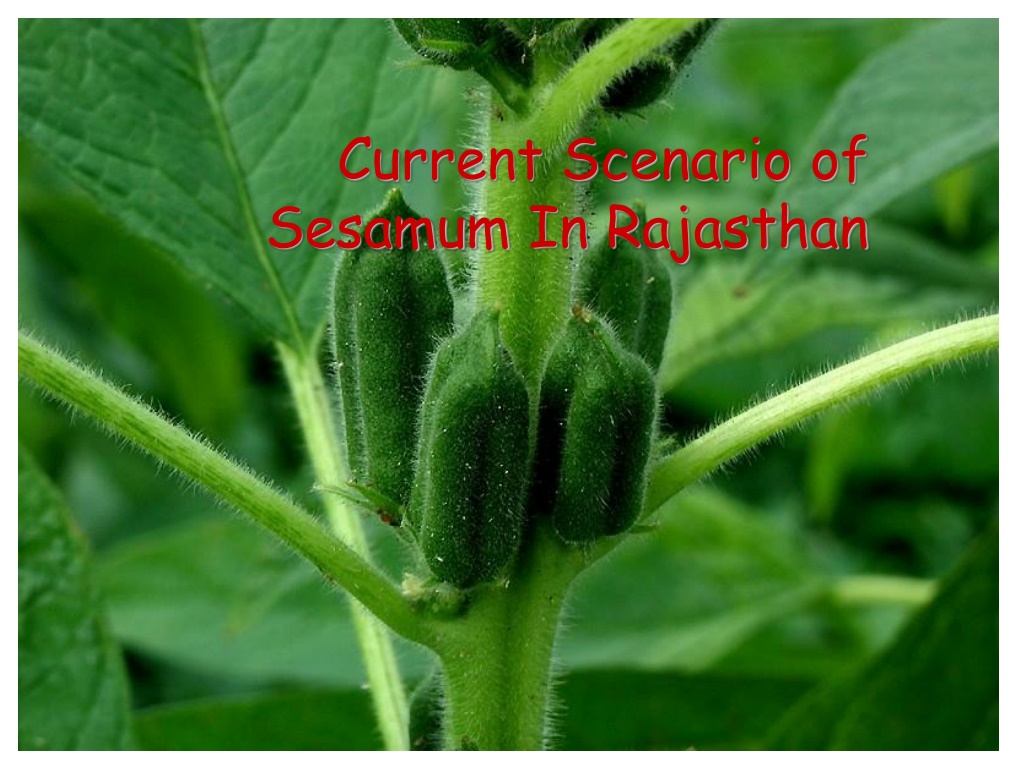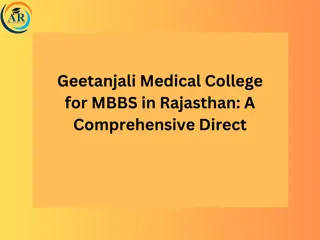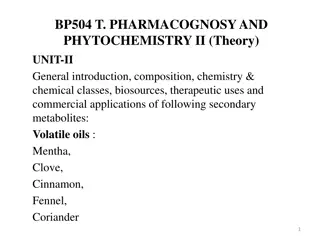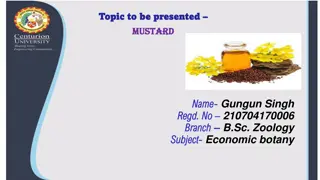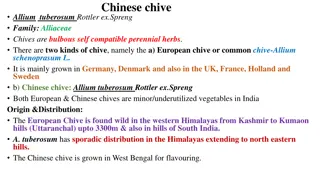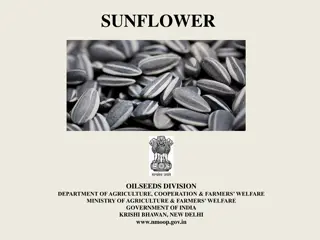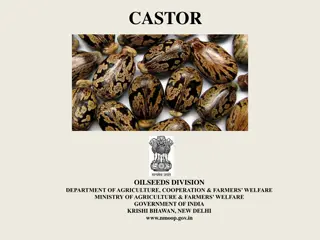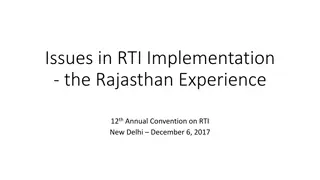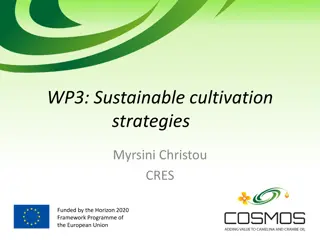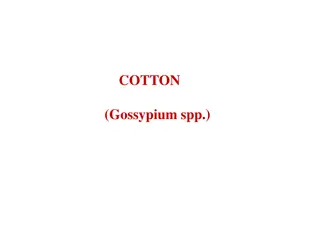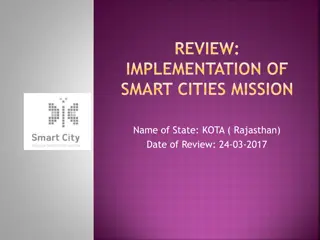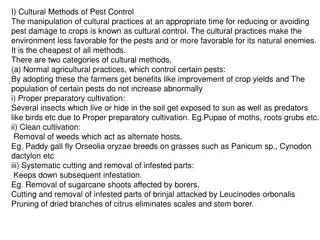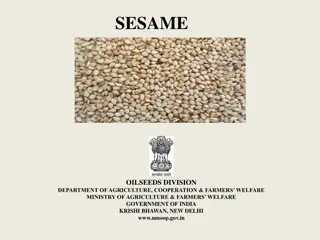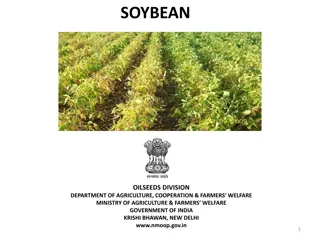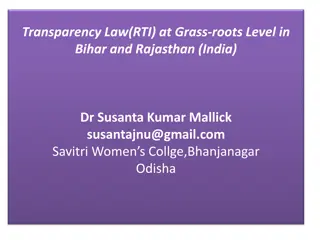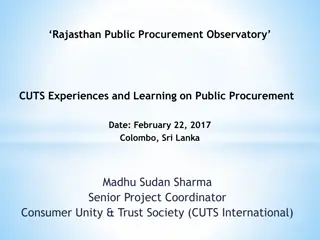Challenges and Opportunities in Sesamum Cultivation in Rajasthan
The current scenario of Sesamum in Rajasthan reveals fluctuating production and export trends, along with challenges such as low productivity, seed replacement rates, and cultivation constraints. Insect pests and major diseases pose threats to Sesamum crops, while the region showcases varieties like RT-346 and RT-351. Adopting Good Agricultural Practices is crucial for enhancing Sesamum cultivation in Rajasthan.
Uploaded on Sep 23, 2024 | 0 Views
Download Presentation

Please find below an Image/Link to download the presentation.
The content on the website is provided AS IS for your information and personal use only. It may not be sold, licensed, or shared on other websites without obtaining consent from the author. Download presentation by click this link. If you encounter any issues during the download, it is possible that the publisher has removed the file from their server.
E N D
Presentation Transcript
Current Scenario of Sesamum In Rajasthan
Production of Sesamum and sesamum oil in India during last five years as follows: (Quantity in lakh tonnes) 2008-09 2009-10 2010-11 2011-12 2012-13 6.40 5.88 8.93 8.1 6.73 Oilseeds 1.98 1.82 2.77 2.51 2.09 Oil
Area, production & productivity of Sesamum in Rajasthan during last five years as follows: 2011-12 2012-13 2013-14 2014-15 2015-16 Avg. 5 yrs 3.29 3.67 5.13 4.15 3.52 4.87 Area (Lac Ha.) 0.95 1.15 1.66 1.22 0.87 1.36 Production (Lac MT) 288 314 324 294 247 280 Yield (Kg/ha)
Export of Sesamum From India (Quantity in lakh tons and Value in Rs. Crores) 2013-14 2011-12 2012-13 Quantity Value Quantity Value Quantity Value 3.89 2.64 2.99 2.88 2.57 3.58 Source: DGCIS/ Trade Estimates
Constraints Low productivity-280 kg/ha Low seed replacement rate as 31.04%(2015-16) Cultivation on less fertile and marginal lands. Sown as a secondary crop. Biotic constraints Pests Disease Abiotic constraints Irrigation Drought
Insect-Pests Leaf webber, roller and capsule borer: Antigastra catalaunalis Hawk or Dead head moth (Sphinx caterpillar): Acherontia styx Linseed gall fly: Dasyneura sesame Gall fly: Asphondylia sesami Leaf hopper: Orosius albicinctus Aphids: Aphis gossypii
Major Diseases Root and stem rot or charcoal rot - Macrophomina phaseolina Leaf blight - Alternaria sesami Leaf spot - Cercospora sesami Wilt - Fusarium oxysporum f.sp. sesami Stem blight - Phytophthora parasitica var. sesami Powdery mildew - Erysiphe cichoracearum (Syn: Oidium acanthospermi) Bacterial leaf spot - Xanthomonas campestris pv. sesami Bacterial leaf spot - Pseudomonas sesami Phyllody - Phytoplasma
Sesamum Varieties grown in Rajasthan RT-346 RT-351 RT-46 RT-125 RT-127 GT-2 G-1
Good Agricultural Practices (GAP) Adoption of Improved Varieties Integrated nutrient and water management Integrated pest and disease management
TBOs with progress of MM-III in Rajasthan The Mission was started in 1st April 2014 and actual plantation started during 2015- 16. In Rajasthan only six TBOs namely Karnaja, Neem, Jatropha, Mahua, Jojoba, and Olive plants are covered under the Mission.
TBOs with progress of MM-III in Rajasthan In the State of Rajasthan the task of Olive cultivation is being looked after by ROCL and Jojoba Cultivation by AJORP (Association of the Rajasthan Jojoba Plantation ). Besides this we have Biofuel Authority (Panchyati Raj and Rural Development Dept.) to promote cultivation of Neem, Karanja, Mahua, and Jatropha. Forest department also promote cultivation of the TBOs in forest areas, under Participatory Forest Management (PPP mode)
Selected District for TBOs Jatropha:- Dungarpur, Chittorgarh, Pratapgarh,Rajsamand. Mahua:- Dungarpur, Chittorgarh, Pratapgarh, Banswara, Rajsamand, Alwar. Karanja :- all districts. Neem:- all districts. Jojoba:- Shri Ganganager, Bikaner, Nagaur, Churu, Hanumangarh, Jaisalmer, Jhunjhunu. Olive:- Shri Ganganager, Bikaner, Nagaur, Churu, Hanumangarh, Jaisalmer, Jhunjhunu, Baran, Tonk, Dholpur, Alwar.
Present Olive plantation Scenario in Rajasthan Plantation at Farmer Field (in Hec.) 0.00 15.50 64.59 49.09 296 Plantation at Govt. Farm (in Hec.) S.No. Year Total 1 2 3 4 5 2008-10 2012-13 2013-14 2014-15 2015-16 (Up to March 2016 Total 182.00 0.00 0.00 0.00 0.00 182.00 15.50 64.59 49.09 296 182.0 425.18 607.18
TBOs with progress of MM-III in Rajasthan Phy . Target (2014-15 & 2015-16) in ha. Achi. Upto 31.07.2016 (in ha) S.No. Tree 1 2 3 4 5 Jatropha Mahua Karanja Neem Jojoba 50 30.40 31 2.45 16.24 20.21 91.66 41.66 141.66 333
Thanks Exit Exit
